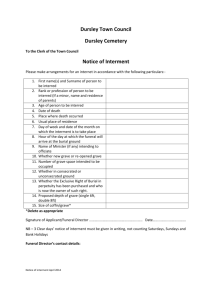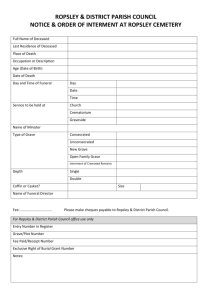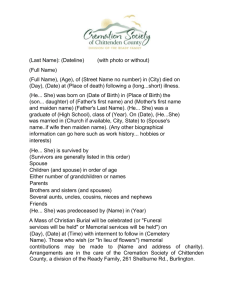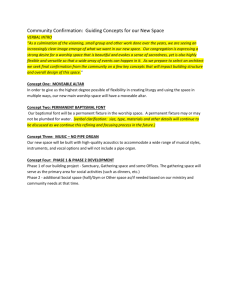about our columbarium - St. David`s Episcopal Church
advertisement
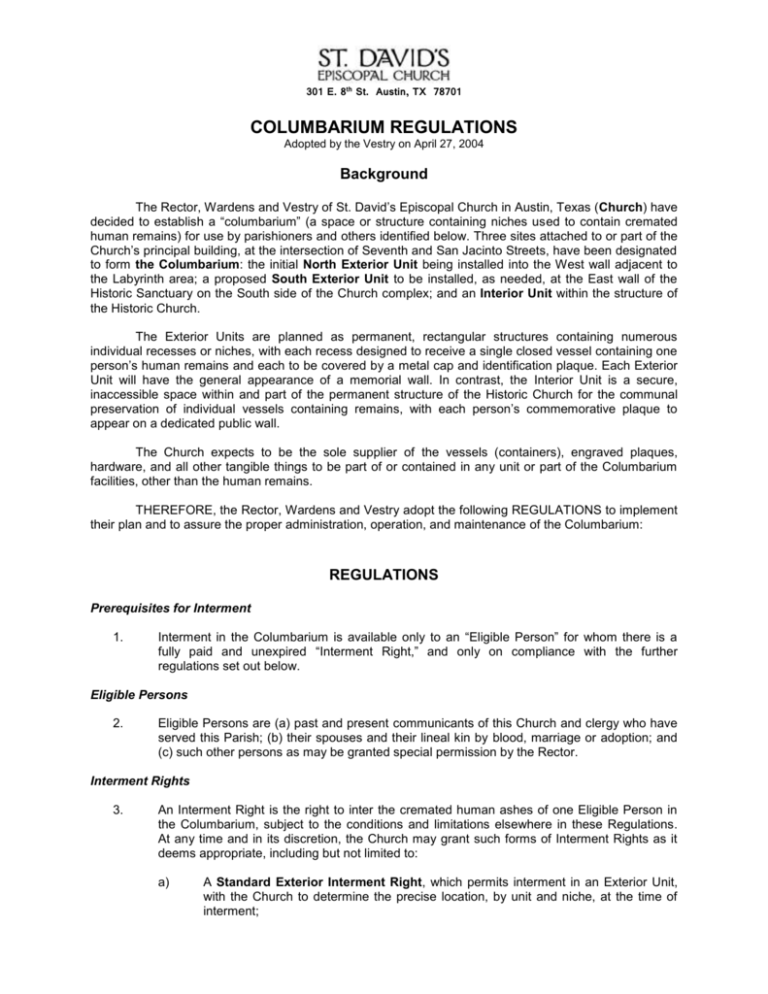
301 E. 8th St. Austin, TX 78701 COLUMBARIUM REGULATIONS Adopted by the Vestry on April 27, 2004 Background The Rector, Wardens and Vestry of St. David’s Episcopal Church in Austin, Texas (Church) have decided to establish a “columbarium” (a space or structure containing niches used to contain cremated human remains) for use by parishioners and others identified below. Three sites attached to or part of the Church’s principal building, at the intersection of Seventh and San Jacinto Streets, have been designated to form the Columbarium: the initial North Exterior Unit being installed into the West wall adjacent to the Labyrinth area; a proposed South Exterior Unit to be installed, as needed, at the East wall of the Historic Sanctuary on the South side of the Church complex; and an Interior Unit within the structure of the Historic Church. The Exterior Units are planned as permanent, rectangular structures containing numerous individual recesses or niches, with each recess designed to receive a single closed vessel containing one person’s human remains and each to be covered by a metal cap and identification plaque. Each Exterior Unit will have the general appearance of a memorial wall. In contrast, the Interior Unit is a secure, inaccessible space within and part of the permanent structure of the Historic Church for the communal preservation of individual vessels containing remains, with each person’s commemorative plaque to appear on a dedicated public wall. The Church expects to be the sole supplier of the vessels (containers), engraved plaques, hardware, and all other tangible things to be part of or contained in any unit or part of the Columbarium facilities, other than the human remains. THEREFORE, the Rector, Wardens and Vestry adopt the following REGULATIONS to implement their plan and to assure the proper administration, operation, and maintenance of the Columbarium: REGULATIONS Prerequisites for Interment 1. Interment in the Columbarium is available only to an “Eligible Person” for whom there is a fully paid and unexpired “Interment Right,” and only on compliance with the further regulations set out below. Eligible Persons 2. Eligible Persons are (a) past and present communicants of this Church and clergy who have served this Parish; (b) their spouses and their lineal kin by blood, marriage or adoption; and (c) such other persons as may be granted special permission by the Rector. Interment Rights 3. An Interment Right is the right to inter the cremated human ashes of one Eligible Person in the Columbarium, subject to the conditions and limitations elsewhere in these Regulations. At any time and in its discretion, the Church may grant such forms of Interment Rights as it deems appropriate, including but not limited to: a) A Standard Exterior Interment Right, which permits interment in an Exterior Unit, with the Church to determine the precise location, by unit and niche, at the time of interment; Columbarium Regulations (cont.) b) c) 4. All Interment Rights for the Exterior Units (including both Standard and Site-Specific Exterior Interment Rights) are subject to the following features, conditions and limitation: a) b) c) d) e) 5. A Site-Specific Exterior Interment Right, which permits the purchaser, at the time of purchase, to reserve a specific Exterior Unit location, by unit and niche, for a future interment; and An Interior Interment Right, which authorizes interment, initial and subsequent, solely in the Interior Unit. Each Exterior Interment Right shall automatically expire on the 35th anniversary of its grant unless renewed by application to the Church on the terms and conditions then in effect. On expiration without renewal, the former right shall automatically convert into a non-expiring right, to be interred in the Interior Unit, but only if space is available in the Interior Unit. At least 90 days before each such expiration date, the Vestry or its designee will try to notify the Interment Rights Owner (defined below) of the upcoming expiration and the renewal options by mail addressed to the last known address or, if unsuccessful, by contacting a known family member. A failure to give notice shall not, however, prevent an expiration of rights, as it is the responsibility of the Interment Rights Owner and his or her family to take the initiative in contacting the Church and preserving Interment Rights. After interment, the transfer of remains between or within the North and South Units is undesirable and should be avoided except for compelling reasons found, in its discretion, by the Church. So that future generations of the Church may have comparable access to the Columbarium, all remains interred for more than 50 years in the Exterior Units may be transferred to the Interior Unit, to remain for the life of the Church at its present location. No such transfer shall be made during the initial 50 years of interment, and without appropriate regulatory approval. Standard Interment Rights are not granted for any specific location, either as between the North and South Exterior Interment Units or within either unit. The Church officials responsible for the placement decision will seriously consider the preferences of Interment Rights owners and family members. (This subsection (e) does not apply to Site-Specific Interment Rights.) The Interment Rights are limited, intangible personal rights and do not create or constitute (and shall not be construed as granting or constituting) any legal interest in, title to, or encumbrance on any realty, land, improvements, fixtures or tangible property, whether real or personal, associated with the Church or any part of its premises, including the Columbarium facilities. Acquisition and Ownership of Interment Rights 6. Any Eligible Person may apply for any number of Interment Rights by submitting the completed application forms and applicable fees then prescribed by the Church. Each application shall be submitted for approval or disapproval at the sole and complete discretion of the Rector or the Rector’s authorized representative, after consultation with the Wardens and Vestry. Any fees accompanying a rejected application shall be returned. 7. Each application shall specify by name and mailing address an Interment Rights Owner, who must be an Eligible Person, but need not be a person anticipating interment in the Columbarium. The ownership of the Interment Rights may thereafter pass by gift, devise, descent or operation of law to others who need not be Eligible Persons; provided, however, (a) no change in the Interment Rights Owner shall be effective until the Church has received written notice showing the names and mailing address of both the prior and new Interment Rights Owners, and (b) no Interment Rights Owner shall be entitled to interment unless he or she is also an Eligible Person. Page 2 of 6 Columbarium Regulations (cont.) 8. It shall be the duty of the Interment Rights Owner (or his or her heirs, devisees, executors or administrators) to notify the Church in writing of any changes in the identity or mailing address of the Interment Rights Owner or, if there is none, the name and mailing address of the appropriate person to receive communications about Interment Rights and other subjects covered by these Regulations. Notice sent by first class U.S. Mail (postage prepaid) to the last known Interment Rights Owner at the last address on file in the Church office shall be considered sufficient and proper legal notification for all purposes, whether or not such purpose be specified in these Regulations. 9. The Interment Rights Owners are prohibited from transferring or permitting the use of Interment Rights for financial gain or remuneration. Interment Procedures 10. Religious services of committal shall be under the authority of the Rector. Sufficient and proper notices of intended interments shall be given to the Rector, and only such religious services as the Rector may conduct or authorize may be performed at the site of the Columbarium or elsewhere at the Church. The interment shall be in the manner directed by the Rector. 11. No interment will be approved or permitted except on written request of the Interment Rights Owner, or his or her heirs, devisees, executors, or administrators. 12. Before delivering the cremated remains to the Church for interment, the funeral home, mortuary or other authorized representative of the deceased must obtain and furnish the Church with all permits or approvals required by local, state or other applicable law. Those representatives, and not the Church, are solely responsible for correctly identifying the person whose remains are delivered. 13. The cremated remains must be delivered to the Church sealed in a vessel that has been furnished, free of additional charge, by the Church. No other vessel or container is permissible. When delivered to the Church, the sealed vessel must contain the cremated ash remains of the one deceased human, and nothing else whatsoever. 14. The clergy and lay representatives of the Church shall not receive or handle any cremated remains except (a) in a sealed vessel previously furnished, empty, by the Church, and (b) only as incidental to interment in the Columbarium. 15. The Church shall not have or assume any responsibility for any permits or legal approvals required for interment, for the identity of the person whose remains are sought to be interred, or for any other irregularity, impropriety or negligence with respect to such remains. 16. The Church, at its sole cost, shall provide an inscribed plaque for each person interred in the Columbarium. The Church will arrange for the engraving, which shall be uniform in size and style, as determined by the Vestry. The maximum inscription shall consist of no more than the name, year of birth and year of death of the deceased. The Church will provide an inscription order form to be completed by typewriter or printed in ink and signed by the authorized person. The Church will not deviate from the inscription data entered on the order form except as necessary to conform with these Regulations or with the instructions on the form, and the Church shall not be responsible for mistakes made by the person completing the form. 17. The Church, to the exclusion of all others, shall supply all vessels, plaques, hardware and other tangible things or objects whatsoever in or part of the Columbarium facilities, with the sole exception of the cremated human remains interred therein. Page 3 of 6 Columbarium Regulations (cont.) 18. The Church shall not be responsible for any order or request given by telephone, or for any mistake arising from the lack of precise and clearly written instructions. 19. No interment shall be permitted and no commemorative plaque inscribed until the fees for the Interment Right have been paid in full, except by special consent of the Rector, after consultation with the Vestry, based on exceptional circumstances. 20. The Church shall keep a permanent record of each interment in the Columbarium and each subsequent transfer or relocation of remains, which shall include the name and, when known, the age of the person whose remains are interred, and the date and precise site of initial Interment and of each subsequent relocation or transfer. The Rector, at his sole discretion, may grant requests from genealogical researchers for access to such records. 21. The Church reserves the absolute discretion and rights (a) to close and deny use of the Columbarium for the interment of any specific individual’s remains, (b) to deny permission to open any Columbarium unit, space, or niche for any purpose, and (c) to deny permission for interment in any particular location. Disinterments (Removals) 22. Except when required by law or by order of a court having jurisdiction, no remains may be removed from the Columbarium without the prior written consent of the Church, which has the sole discretion to grant or withhold consent, based on the circumstances presented. All removals shall comply with applicable laws and court orders. 23. Removals by heirs, Interment Rights Owners, or their successors-in-interest for financial gain or remuneration are repugnant to ordinary decency and are absolutely prohibited. Removal of Columbarium 24. If for any reason the Church ceases to exist in its present location, or if its facilities are converted to non-church use, the persons then having authority and responsibility for the affairs of the Church (which may be the governing authorities of the Protestant Episcopal Church in the Diocese of Texas) shall be responsible for the removal of all remains in the Columbarium and their reinterment at a new location designated for columbarium use or, alternatively, if another site is not feasible for such use, in the Gulf of Mexico beyond the 15mile coastal limit of the United States of America, and in any event all at the Church’s sole cost. Flowers and Ornaments in Columbarium Areas 25. No flowers or plants may be placed in the Columbarium areas at any time except as directed or permitted by the Rector. 26. No art works, decorations, embellishments, ornaments or other tangible things (for example, boxes, cans, shells, toys, wreaths, metal designs, ornaments, signs, posters, cards, furniture, vases, pictures, artificial flowers, flags or emblems) shall be permitted or placed in the Columbarium areas without the prior approval of the Rector. Items placed in violation of this Regulation may be removed and disposed of without notice or liability to the owner or person placing them. Conduct in Columbarium Areas Page 4 of 6 Columbarium Regulations (cont.) 27. Except as a Church-sponsored event or Labyrinth activity, or with the Rector’s prior permission, all ceremonies, commemorative gatherings and demonstrations, religious or secular, shall be prohibited in Columbarium areas. 28. The Columbarium sites are part of the Church, and all persons entering their vicinity are expected to conduct themselves in accordance with customary good decorum as normally observed in an Episcopal Church. 29. The Rector and Wardens and, in their absence, the Vestry are empowered to enforce appropriate decorum and to exclude from the Columbarium areas any person who misbehaves. Governance and Superintendence 30. The Columbarium is a part of the Church which operates under the direction of its Rector, Wardens and Vestry. The Rector, Wardens and Vestry may, consistent with canon law, designate and empower subordinate clergy, committees and individuals to carry out the terms of these Regulations. “Rector,” when the Church has none, refers to the Wardens or any Member of the Clergy serving as Interim Rector under the authority of the Bishop of Texas. 31. All questions about Columbarium use shall be directed to the Rector, or such clergy or lay employees as the Rector may designate. 32. Beyond routine maintenance and oversight, Church employees shall not execute any work or orders concerning the Columbarium except on order of the Vestry or Rector or their designees. 33. The physical facilities associated with the Columbarium shall be routinely well maintained and supervised in the same manner as other Church facilities. 34. The Columbarium and all associated activities (including, for example, interments, disinterments, and removals) are subject to the laws and orders of properly constituted authorities of the City of Austin, Travis County, the State of Texas and the United States. Exceptions and Amendments 35. Special situations may arise in which the literal enforcement of these Regulations may impose unnecessary hardship. Therefore, the Rector, Wardens or Vestry, as their interests may appear, may make exceptions, suspensions or temporary modifications in any of these Regulations when it appears advisable, but no such special or temporary deviation shall affect the general application of these Regulations or applicable law. Not a Cemetery 36. Except as applicable law may otherwise prescribe, the Columbarium is not a cemetery, and it has not and will not be used or dedicated as a cemetery. It is not, for example, a perpetual care cemetery, permanent maintenance cemetery, or free care cemetery. The Church has no legal obligation for the perpetual or free care of the Columbarium or for its permanent maintenance. Protection Against Loss 37. The Church may carry such insurance for its own benefit on the Columbarium and contents as the Vestry sees fit; however, the Church and Vestry have no obligation to provide any insurance for the benefit of Interment Right Owners or decedents, or their heirs or other representatives. Neither the Episcopal Diocese of Texas, nor the Church, nor its Rector, Page 5 of 6 Columbarium Regulations (cont.) Wardens and Vestry, nor the clergy, boards, committees, councils, agents, employees or representatives affiliated with such entities or offices shall be liable for damage to, or loss of, interred remains. The Church shall, to no greater extent than it takes measures to protect its property at its current location, take precautions to protect within the Columbarium the interest of the Interment Rights Owner and other affected parties, but the Church distinctly shall not be responsible for loss or damage from causes beyond its control, and, especially, from damage caused by the elements, an Act of God, common enemy, thieves, vandals, strikers, malicious mischief makers, flood, fire, explosions, unavoidable accidents, invasions, insurrections, riots, civil commotion or order of any civil or military authority, whether the damage be direct or collateral. By acceptance of Interment Rights in accordance with these Regulations, the Interment Rights Owner releases and saves harmless the Church and all other persons identified in the second sentence of this Paragraph 37 from any claims, demands, liability and causes of action by reason of their administration, maintenance, conversion, conveyance or alienation of the Columbarium or any part, unit, space, or niche thereof. Miscellaneous: 38. All sums paid to the Church for the purchase or renewal of Interment Rights shall be for the unrestricted use of the Church as the Church, in its discretion, deems appropriate. 39. The Church may at any time adopt new regulations, or amend, alter, or repeal any regulation, paragraph or sentence in these Regulations. 40. The Church’s construction or interpretation of these Regulations shall be conclusive, final and binding. 41. If any provision of these Regulations is found to be invalid in whole or in part, these Regulations shall, except only to the extent of such partial invalidity, remain valid and effective. Page 6 of 6
![[Date] The Honorable ? Room ? State Capitol P.O. Box 8952](http://s3.studylib.net/store/data/007099882_1-8776cc996cc8ea772e2d2bd07029a1f5-300x300.png)
